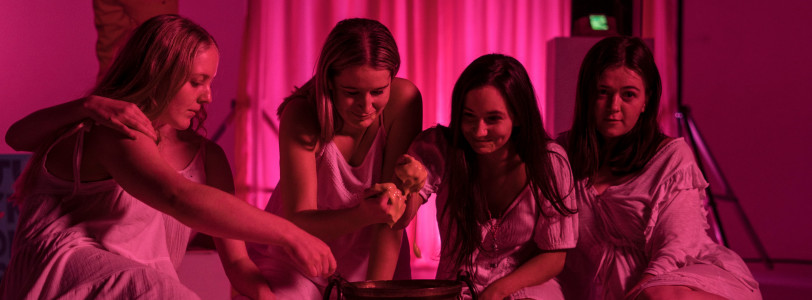Watch Justin, What Have You Done To Us? here.
From the moment I saw the premise of this short film by Leanne Judge I knew it was something I had to review. Partly since, as a music student, looking at a piece examining one of Pop’s most simultaneously loved and (let’s face it: mostly) reviled figures felt like a writer’s obligation for me.
In a shrine illuminated in pink, five women begin a ceremony in honour of Justin Bieber. It’s purpose, unknown, but they will dance, present offerings, and partake in strange rituals to the floppy-haired deity.
The imagery of this piece also immediately struck me, perhaps partly because of an interest in classics I’ve held since I was a kid. This film leans on ritual and temple imagery, straddling a line somewhere between modern druidic dance ceremonies and a setting that could have easily been the home of the Oracle of Delphi. This was combined with the costume choices, which had the five actresses in simple white dresses which gave the impression of conjuring images of the Vestal Virgins of Ancient Rome. Beyond this, the placing of a wreath atop a cardboard cutout of Bieber like a Roman commander at their triumph or a statue of a deity, and the use of tears as an ingredient to create some kind of potion in a Greco-roman pot all adds brilliantly to evoking this temple/ritual feel.
This is all then contrasted by the modern paraphernalia that surrounds the ritual: merchandise, t-shirts, banners drawn in a childish crayon-and-felt-tip style. There are, of course, offerings made to the fringed deity, including flowers, an iPod, and a book with the words to the song Baby written on in felt-tip and glitter, and the modern ritual of the combining of two necklaces to complete a heart shape with the name of a significant other – in this case as part of the adoration of Bieber.
Adding to all this is an inspired soundtrack with rattles, a regular low drumbeat, and over-tracked flutes of different types, undercut with some synthesiser interjections; again creating the idea of a cross between old ritual soundscapes and more modern sounds. Frankly, I think they missed out on an opportunity here to somehow quote or slip in an extract of one of Bieber’s songs, although I imagine the copyright implications might have made that hard. That being said, that might be part of the point. The music is not what’s being idolised here, the film is trying to show how Justin Bieber as both a man and as an idolisation of the idea of the teenage heart-throb is what is being worshipped here. The paraphernalia and all the trappings of the worship are brought in but the substance of the man’s music never is. The quality of the music was never what was the generator of Bieber-fever, it was the idea of Bieber as an idol.
The acting was executed well, although it does have to be said that this is much easier when the prompts are largely “look wistful and adoringly at person/thing”. The dancing is perhaps the main technical point to applaud here, with the performers moving from tightly choreographed circle dances to more frenetic and freestyle expressionist dance (again showing the mix of the traditional and the modern). The camerawork is far from revolutionary but combines a good mix of tight shots focussing on individual actors and wider shots to show the wider ritual scene. I think it could have been improved with a little more moving camerawork on the dancers to follow their motion, as the shots do feel a little static. I’m thinking particularly of the Druid dance in Outlander which executes this brilliantly. The lighting covers everything in a pink haze which I imagine is exactly what a preteen girl’s rose-tinted glasses dream-sequence might look like. Since subtlety is hardly a factor here, I think the whole thing could have been amped up with a little stage smoke, just to increase the mysticism of the ritual.
The imagery has formed the largest part of my review of this piece and that is because it largely dominates the film. This is not a character-driven piece nor a dance film, but a spectacle. It highlights the various largely invisible, psychological, and virtual aspects of fandom by presenting them through the lens of traditional rituals of worship and adoration. As such, it is easy to create an interpretation of this work that is almost a play by play analogy to modern fandom practices.
The offerings, for instance, become representations of fans’ physical manifestations of their adoration, by doodling on their books or having the idol’s doctrine (in this case Bieber’s music) on their person at all times. The chanting of his name is part of the endless adoring discussion of the star. The dancing is very simply representative of people dancing along to his songs, either together or alone in their bedrooms.
However, the whole potion/fondue thing kind of defeats me, I don’t see any allegory for it and this leads me into thinking it is mostly there for shock value, as seeing the five dancers eating what looks like raw stringy meat certainly made me recoil on the first viewing (and still gave the urge to retch on subsequent views). Here, maybe others will be able to see what I cannot, but as someone reticent to ask a creator to hold my hand in interpreting a work, this strikes me as something of a failure to communicate intent to the audience.
My best guess is that this section is generally supposed to be something of a tonal shift from harmless bizzarity to perverseness. However, since this is so close to the end of the piece it just seems to come out of nowhere and is not developed any further than those few shots of them eating the strange mixture with increasing gusto. Contrast this with something like Billie Eilish’s When the Party’s Over video, which also sees the character consume something kind of gross, but the context gives more of an idea of what you might interpret from it (personallyI took it that she drinks in the sadness — here her dysfunctional relationship — which later consumes her). Here, it only serves to tonally confuse the piece which is a shame when its imagery was so strong. The same applies to the ending with the sudden deadpan 4th wall break.
Overall then, Justin, What Have You Done To Us? is a film that very successfully creates imagery that describes some aspects of fandom, as depicted through a surrealist lens of ancient ritual and modern merchandise. Its score brilliantly supports this strange world the set and the performers create. However, it feels like in a desire for subversiveness the film undermines the tone that it sets up so carefully at the beginning – all the more problematic in a film which has established its atmosphere to be at the core of the experience.
We also interviewed New Creative Leanna Judge, and you can hear that conversation here.
New Creatives is a talent development scheme supported by Arts Council England and BBC Arts. Check out our New Creatives coverage in the New Creatives Voicebox.









0 Comments